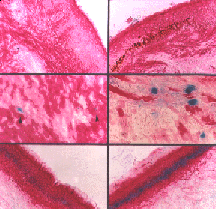Biomarker for Cell Senescence
A test developed by Berkeley National Laboratory researchers uses blue stain to detect the presence of senescent cells. The assay top left shows young tissue with no presence of blue; top right is young sunburned tissue, also negative. Older tissue cells, pictured in the bottom four assays, contain blue areas revealing evidence of the existence of senescent cells.APPLICATIONS OF TECHNOLOGY:
- Screen compounds for effects on cell senescence, including high throughput applications - Pre and post surgical tissue assay - Cancer and aging research
ADVANTAGES:
This method provides a rapid, convenient and inexpensive basis to:
- Screen biological or pharmaceutical compounds that have anti-tumor, anti-aging, or proliferation-modulating properties. - Identify senescent cells in culture without the use of radioactivity or costly and time-consuming immunodetection methods. - Identify senescent cells in situ in tissues or in freshly isolated cells, to distinguish them from quiescent, terminally differentiated, or physiologically compromised cells. This will provide a means to evaluate, in vivo, the physiological, as opposed to chronological, age of the tissue. - Separate, quantitate, and culture senescent cells from heterogeneous cell populations. - Rapidly provides information useful for pre- and post-surgical diagnoses and prognoses such as:
- Degree to which benign or malignant tumors have escaped senescence, - Regenerative capacity of tissues prior to surgical procedures, - Extent of proliferative capacity of a tissue or cell type
ABSTRACT:
Eukaryotic cells, after proceeding through a finite number of cell divisions, enter a state characterized by irreversible growth arrest and altered function. Judith Campisi, Goberdhan Dimri and Monica Peacocke at Berkeley Lab believe that entry into this senescent state is a dominant, genetically controlled process that constitutes a tumor suppressive mechanism. Berkeley Lab and New England Medical Center researchers have now developed a convenient, single cell-based technique that readily identifies senescent cells in heterogeneous populations. This is the first biomarker of cell senescence that does not rely on measurements of DNA synthesis for detection. Berkeley Lab's method clearly distinguishes senescent cells from quiescent, terminally differentiated or physiologically compromised cells grown in vitro. This method also identifies the senescent state in cells of certain tissues grown in vivo, including skin cells. Berkeley Lab's technique will provide a valuable tool to develop rational interventions in the areas of aging and cancer. A convenient kit incorporating Berkeley Lab's procedure, useful to medical staff in offices and hospitals, would simply, immediately, and inexpensively aid in the diagnosis and prognosis of a variety of surgical procedures and pharmaceutical regimens.
Attached files:

Patents:
US 5,795,728
US 5,491,069
Inventor(s): Judith Campisi, Goberdhan Dimri and Monica Peacocke
Type of Offer: Licensing
« More Medical Patents
